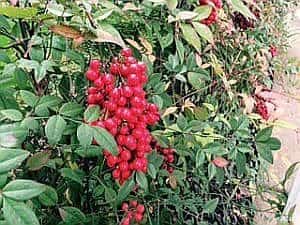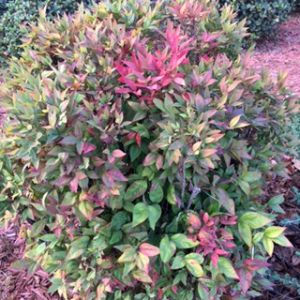
Nandina
Heavenly Bamboo
Sacred Bamboo
Nandina domestica is not a bamboo but an evergreen shrub originating from Asia. It is a member of the Barberry family has been grown as an ornamental plant in New Orleans since the 1850s, 1885. This is a clumping plant with an oval shape and stiff canes. The plant can reach 8 feet tall. It prefers full sun to part shade. Nandina prefers rich, organic moist soil but is drought tolerant once well established. Compound Leaves are bipinnate and tripinnate with pointed tips, delicate red-tinged to wine red–tinged. It produces 6 to 12 inch clusters of white flowers in late April/May and bright red berries in fall and winter. More berries and color appear in cooler climates. The berries and new leaflets offer bright red color to the landscape and winter food for birds. Berries are ideal for arrangements and Christmas decorations.
All parts of Nandina domestica are poisonous containing compounds that decompose to produce hydrogen cyanide and could be fatal if ingested by cats and grazing animals but generally not considered poisonous to humans. Birds are generally not affected by these toxins and will disperse the seeds through their droppings. Excessive consumption of berries will kill birds such as Cedar Waxwings, however. Due to these naturally occurring phytochemicals, this plant is commonly used in rabbit, deer resistant landscape plantings. Considered invasive in some southern states but not in Louisiana.
Plant Nandina from containers anytime during the year. Fertilize in February with a complete fertilizer or slow release fertilizer of no more of ¼ to 1/3 cup for more color and berries. Propagate by seeds, division of clumps and cuttings made in winter.

The regular Nandina plant has no known pest problems. Miniature varieties may have problems with powdery mildew which can be contained with frequent spraying. Pruning may be necessary to keep Nandina to a desired size by pruning out canes to the ground. Prune 1/3 of the larger canes to contain the plant size.
‘Compacta’, ‘Nana’, ‘Pygmaea’ and ‘Harbor Dwarf’ are some small growing varieties. ‘Plum Passion’ has deep purplish new growth. ‘Alba’ is a white fruiting variety but less popular.
submitted by Karen Blackburn



